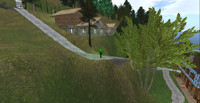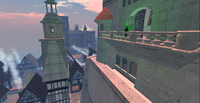Confederation of Democratic Simulators
Confederation of Democratic Simulators (also listed with temporary name A230) is a Microcontinent located at Coordinates 962-963/975-978, Grid Sector I9, inside Little Pacific Ocean.
History
Behind this microcontinent is a long story, dating from September 21st 2004. It was founded by one of the oldest groups on the grid. At the beginning, it was named Neualtenburg Project. Neualtenburg was first a Bavarian themed project, first hosted in mainland (Anzere sim, in Snowlands Subcontinent). In 2005, the project moved to a private-owned region and changed the region name into Neufreistadt. Later, a new region was added, Colonia Nova. Once this step was made, the group, by referendum, changed its name to Confederation of Democratic Simulators (CDS). Other regions were added, resulting in the formation of a microcontinent.
On September 21st 2014, the group celebrated its 10th anniversary. On September 21st 2024, it celebrated its second decade, and considers itself the uninterrupted longest-running community in Second Life — or, at least, the longest-running democratic community in Second Life. The community size has remained constant over the decades, roughly around 80 citizens, although in recent years it has been steadily growing (but very slowly so). The lowest number of registered citizens was 4, during a short period after the move from mainland Anzere to their first private region; the peak was roughly 120 citizens during a comparatively short period of time when the CDS was merged together with the Al-Andaluz community.´
For up to date information about the CDS, visit their website. The CDS is not a role-playing community.
Position and structure
A230 is made of 6 regions connected in a way that they are more compact. It is placed close to A163 - State Of Mind Microcontinent, inside Little Pacific Ocean, East (and not far) from Estate Continent. The second nearest continent is Sansara, also to East.
Since 2020, A230 has been moved to be integrated within the education area — an area in the map set aside by Linden Lab to accommodate estates either owned by academic institutions and research labs, or which main purpose is of an educational nature (as opposed to, say, for-profit land rentals), and overall management by the Virtual World Education Consortium (VWEC). It has also established waterways in a three-party agreement with two neighbouring fellow VWEC estates.
Geography
There are 6 connected regions: Neufreistadt, Friedsee, Colonia Nova, Alpine Meadow, Locus Amoenus and Monastery. The first 5 are full regions, while the last is a homestead.
Altitude seems to be the highest of all private-owned land, 183 meters in Neufreistadt. There are many mountains in the South, while in the North land is more flat. There are rivers that flow through land, some of them are navigable, but still water covers only a small part of some regions. Ground is covered with grass (except in winter, when this place becomes a snowland). Ground texture (in summer) is more to brown on mountain top and more to green on water shores.
Wild nature is present. There are many plants and animals waiting you.
Each region has its own covenant and theme, with two dominant themes present. The oldest region, Neufreistadt, was deliberately placed on a mountain region and is built in medieval pseudo-Bavarian style, but with some postmodern buildings (a deliberate choice for a city which is not "frozen in time" but has a vibrant community which changes and adapts the city to suit their purposes, just like in real life). The original inspiration came from the Bavarian town of Rothenburg. The city itself is a walled enclosure which covers about ⅓ of the region, at its highest point, where there is a large Schloss (German for a palace/castle). Since the highest altitude is 183 meters and the highest tower of the castle rises to 257 meters, the result is that the building's height is 74 meters. This place it as one of the highest buildings on the grid and for sure one of the highest medieval constructions. While higher mountains exist in the mainland, the city of Neufreistadt is actually the largest, uninterrupted community living in an urban area at the highest altitude. Originally, due to its extreme height, it would be almost always inside the cloud layer (which is set by default on the viewer at about 170-175 meters), giving it a very mysterious look; these days, thanks to Windlight and EEP, such settings are tweaked in order to make everything less "foggy".
The second oldest region is Colonia Nova, where the original theme was inspired by the Roman Empire city of Colonia Nova (where today the German city of Köln is located). It is a reinterpretation of how such a Roman city might have survived to the present day while still being modified and adapted with contemporary amenities. Just like some Insulas in Rome are still inhabited today — continuously occupied for twenty centuries! — Colonia Nova captures that concept and expands it to a full city, which, again, occupies about ⅓ of the region. It is also a walled city, but most parts of the wall have been (deliberately) incorporated into new buildings (as historically would be the case). Unlike Neufreistadt, which is high up in the mountains, Colonia Nova lies by the river Rhenus and his its own docks (now a fancy, trendy, hip area, just like it would be the case in contemporary European cities). The outskirts of Colonia Nova are not so strictly Roman-inspired (or, if they are, they might — again, deliberately — not be historically accurate, but rather modern reinterpretations of the Roman style), and, towards the ocean, the buildings slowly becomes more Mediterranean in style.
Alpine Meadow is a quasi-vertical region, connecting Neufreistadt with Colonia Nova. It is still considered an Alpine region — as are the Monastery and Friedsee — but where it connects to Colonia Nova, the parcels are flatter and there is a clear transition towards a more Mediterranean style, mimicking existing towns in Italy which still have the Alps as a background.
Locus Amoenus (literally, "a nice place") is the extension of Colonia Nova towards the ocean, and it gradually loses the strict Roman style (where it connects to the city of Colonia Nova) and becomes much more Mediterranean in style, with fishing villages and a much more (stereo)typical Italian look.
Please note that in the Alpine regions, many names and signs are written in German and you might also find greeters that use both German and English messages. By contrast, signs in and around Colonia Nova might be in Latin, with a subtle transition towards (contemporary) Italian at the coast. English is still the official language, no matter what nationality the citizens come from (and they come — literally — from around the world, from New Zealand and Australia, to Canada and the United States, while half the citizens come from several countries in Europe).
Thanks to an agreement with neighbouring estates, part of the ocean is navigable, allowing travel by water to them. There are plans to extend the navigable ocean to more regions, but since that has a considerable cost (water regions are not suitable for rentals), such expansion will very likely be very slow.
Accessibility
The microcontinent has an extensive network of paved roads, that allow access to nearly every parcel. They use large bridges to pass over rivers. A high number of smaller paths (even unpaved) and town streets can also be used. Walking on grass is allowed, there are no ban lines or entity orbs.
Land status
All are welcome to visit, explore, and become a part of the community.
Land in the CDS is considered to be collectively owned and managed (there is no "estate owner" with an overarching authority), therefore, owning land automatically implies citizenship, with the right to vote, run for office, and have a say in the direction and projects of the regions.
Land owners are subject to a substantial covenant (which varies from region to region; some areas are stricter than others), but, in general, residents can do whatever they want on their parcels (this is "full ownership on a private island", not a rental). Skyboxes are ok.
Not all of the land is available for sale: like on the mainland, a (substantial) part of the regions are reserved as "public land". These are free to use by anybody — such as roads, parks, and even several buildings — subject to common sense rules (such as asking first for permission to host an event on public land, to make sure it doesn't conflict with someone else's event on the same spot on the same day).
Because the purpose of the CDS is not profit, but keeping a long-lasting community around, land prices are usually little more than the cost of paying Linden Lab for the region simulators. A small share of the parcel fees will go towards paying for the public land, maintaining the website, event promotion, and assorted expenses, which are decided in advance, via a 6-month-budget that needs to be presented for voting. Over the years, therefore, the CDS has not accumulated a substantial fortune, but it nevertheless replenishes an "emergency fund" allowing it to continue to pay Linden Lab for several months, even in the case of a catastrophic exodus for some unpredictable reason, without the need to immediately raise tier fees on those parcels owned by the remaining citizens. While this has never happened, because Linden Lab's tier fees may change without further notice, some adjustments may be needed to cope with these circumstances beyond the citizen's control, and the "emergency fund" allows such decisions to be made after a period of careful ponderation and analysis.

